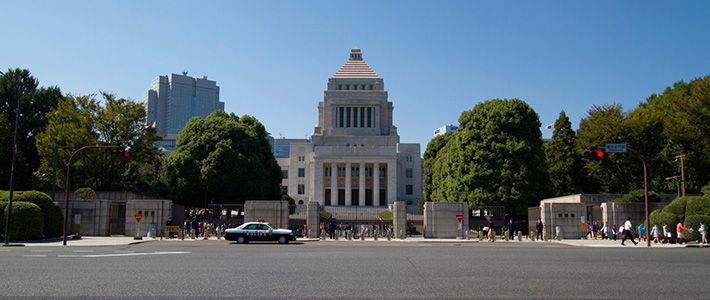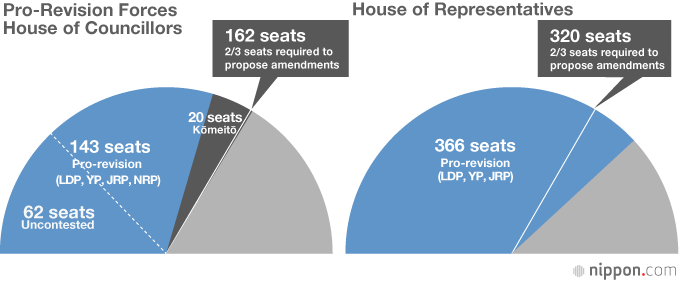
2013 House of Councillors Election Results at a Glance
Politics- English
- 日本語
- 简体字
- 繁體字
- Français
- Español
- العربية
- Русский
The twenty-third House of Councillors election on July 21, 2013, ended in a landslide victory for the ruling coalition of the Liberal Democratic Party and New Kōmeitō. Adding their newly elected Diet members to those with uncontested seats, the coalition now enjoys a majority in the 242-seat upper house. As a result, the so-called twisted Diet, in which different groups of parties controlled the upper and lower houses of Japan’s bicameral parliament, has been eliminated. The twisted Diet phenomenon had dominated Japanese politics since the twenty-first House of Councillors election, which took place in 2007, during the previous administration of Prime Minister Abe Shinzō.
What happened in the House of Councillors election? Below we present the results at a glance.
A Healthy Majority in Place
Of the 242 seats in the House of Councillors, 121 seats were contested this time (73 electoral-district seats and 48 proportional-representation seats). The ruling LDP and Kōmeitō coalition won 76 seats in the election, giving them a total of 135 seats, 32 more than before the election. The opposition parties, including the Democratic Party of Japan, captured just 45 seats in the election, giving them a total of only 107 seats in the upper house.
As a result, the ruling parties now hold 55.8% of the seats in the upper house and the opposition parties and independents just 44.2%. Looking solely at the seats up for grabs in this contest, however, the ruling parties won an even healthier 62.8% of the contested seats (76) against the opposition’s 37.2% (45).
| Seats won in 2013 election | Uncontested seats | Post-election strength | Pre-election strength | |
|---|---|---|---|---|
| Liberal Democratic Party | 65 | 50 | 115 | 84 |
| New Kōmeitō | 11 | 9 | 20 | 19 |
| Japan Restoration Party | 8 | 1 | 9 | 3 |
| Your Party | 8 | 10 | 18 | 13 |
| People’s Life Party | 0 | 2 | 2 | 8 |
| Social Democratic Party | 1 | 2 | 3 | 4 |
| Greens Japan | 0 | 0 | 0 | 4 |
| New Renaissance Party | - | 1 | 1 | 1 |
| New Party Daichi | 0 | 0 | 0 | 1 |
| Independents | 3 | 1 | 4 | 8 |
| Japanese Communist Party | 8 | 3 | 11 | 6 |
| Democratic Party of Japan | 17 | 42 | 59 | 86 |
Note: There were five vacancies before the official announcement of the election.
LDP Wins 29 of 31 Single-Member Districts
Three reasons have been cited for the landslide victory of the ruling parties in the upper house election: (1) the downfall of the Democratic Party of Japan, (2) the rivalry and balking among the opposition parties caused by their disunity, and (3) the low voter turnout. Among them, the LDP’s supremacy and DPJ’s downfall were shown most clearly in the 31 single-member districts, where the LDP lost just two contests and acquired its highest ever number of seats in this category. The LDP’s only defeats were in Iwate and Okinawa. By contrast, the DPJ was defeated in all 19 single-member districts in which it fielded candidates. (Following a revision of the Public Office Election Act in 2012, the two-member Fukushima and Gifu districts became single-member districts, so in the 2013 upper house election the number of single-member districts increased from 29 to 31.)
The voter turnout ratio in the 2013 upper house election was 52.61%. This was the third lowest figure since 1945 and marked a 5.31-point drop from the 57.92% in the previous upper house election in 2010.
Seats Won in Single-Member Districts Since 1989
| Upper house election | No. of single-member districts | Ruling parties | Opposition parties |
|---|---|---|---|
| 1989 | 26 | 3 | 23 |
| 1992 | 26 | 24 | 2 |
| 1995 | 24 | 19 | 5 |
| 1998 | 24 | 16 | 8 |
| 2001 | 27 | 25 | 2 |
| 2004 | 27 | 14 | 13 |
| 2007 | 29 | 6 | 23 |
| 2010 | 29 | 8 | 21 |
| 2013 | 31 | 29 | 2 |
Breakdown of LDP-DPJ Cohabitation in Two-Member Districts
In multimember districts (2–5 seats), all 18 candidates fielded by the LDP and 4 by Kōmeitō won election. In contrast, the DPJ, which appeared likely to acquire one seat each in the five-member Tokyo, four-member Osaka, and three-member Saitama districts, suffered a complete rout, losing all three of these urban seats.
In the three consecutive upper house elections since 2004, the LDP and DPJ had evenly split the 10 two-member districts, winning 10 seats each, but this time the cohabitation structure broke down. While the LDP won its usual 10 seats, the DPJ secured only 7, the remaining 3 going to the Your Party, Japanese Communist Party, and Japan Restoration Party.
| 5-member districts | 4-member districts | 3-member districts | 2-member districts | Total | |
|---|---|---|---|---|---|
| No. of districts | 1 (5 seats) | 2 (8 seats) | 3 (9 seats) | 10 (20 seats) | 16 (42 seats) |
| LDP | 2 | 2 | 4 | 10 | 18 |
| Kōmeitō | 1 | 2 | 1 | 4 | |
| DPJ | 1 | 2 | 7 | 10 | |
| Your Party | 1 | 2 | 1 | 4 | |
| JRP | 1 | 1 | 2 | ||
| JCP | 1 | 1 | 1 | 3 | |
| Independents | 1 | 1 |
“Third Force” Struggles; JCP Gains
Although the Japan Restoration Party, which made its debut in an upper house election, and the Your Party put up fairly decent fights, winning eight seats each (two electoral-district and six proportional-representation seats for the JRP, four electoral-district and four proportional-representation seats for the Your Party), overall the so-called third force,which was thought to hold the key to political reorganization from now on, did not fare very well. In particular, the Your Party saw its presence in the upper house drop from 10 seats before the election, and in the proportional-representation segment it received 4.75 million votes (8.9% of the total), far fewer than the 7.94 million votes (13.6%) it garnered last time.
The JRP surpassed the Your Party in the proportional-representation segment, attracting 6.35 million votes (11.9%). Together these two parties collected 11.10 million votes in this segment, which was about 4 million more than the DPJ’s 7.13 million votes. If they had achieved some degree of cooperation in the election, these “third force” parties might have emerged with a firm foundation for reorganization. However, they competed in the 10 multi-member districts and ended up holding each other back.
The Japanese Communist Party, meanwhile, became a new 11-seat force in the upper house and recovered the right to submit bills to the Diet, granted to parties with 10 seats or more. The JCP, which went into the election with three uncontested seats and three it was seeking to defend, won eight seats (three electoral-district and five proportional-representation seats). It was the first time in 15 years for the JCP to make gains in a national election and the first time in 12 years, since the 2001 upper house election, for it to capture electoral-district seats. (The JCP acquired seats in the electoral districts of Tokyo, Osaka, and Kyoto.) The Communists received a total of 10.79 million votes, more than the “third-force” JRP and Your Party.
| Seats won in 2013 election | Uncontested seats | Post-election strength | Pre-election strength | Increase | |
|---|---|---|---|---|---|
| Your Party | 8 | 10 | 18 | 13 | +5 |
| Japan Restoration Party | 8 | 1 | 9 | 3 | +6 |
| Japanese Communist Party | 8 | 3 | 11 | 6 | +5 |
| Proportional- representation seats | Single-district seats | Total | |
|---|---|---|---|
| No. of votes | No. of votes | Total no. of votes | |
| Your Party | 4 | 4 | 8 |
| 4.75 million | 4.16 million | 8.91 million | |
| Japan Restoration Party | 6 | 2 | 8 |
| 6.35 million | 3.84 million | 10.19 million | |
| Japanese Communist Party | 5 | 3 | 8 |
| 5.15 million | 5.64 million | 10.79 million |
Constitutional Revisionists Fall Short
Election-watchers focused their attention on how many seats would go to the parties in favor of revising the Japanese Constitution, namely the LDP, Your Party, JRP, and New Renaissance Party. After the poll, these constitutional revisionist forces have a combined total of 143 seats. This falls short of the two-thirds threshold of 162 seats in the upper house required to propose a constitutional amendment.
If the LDP’s coalition partner Kōmeitō were added, the constitutional revisionists would exceed the threshold with 163 seats. But the Kōmeitō has shown a cautious stance toward revising the nation’s basic law. The reality is that the pro-amendment forces face quite a stiff task.
In the 480-seat House of Representatives, meanwhile, the three parties in favor of constitutional revision are the LDP (295 seats), JRP (53 seats), and Your Party (18 seats). These three parties therefore have a combined total of 366 seats, far exceeding the two-thirds threshold of 320 seats. The Kōmeitō has 31 seats in the lower house.

The Internet: Net Yet a Major Factor
Following the enactment of a revised Public Office Election Act in April 2013, the ban on electoral campaigning via the Internet was lifted for the first time in the July upper house election. Not only parties and candidates but voters as well were able to use websites to support specific candidates.
According to exit polls conducted by media organizations, however, only around 10% of voters replied that they had used online campaigning as a reference. Over 80% said that they had not used the Internet in deciding who to vote for. Even more Internet-savvy young people made little use of the Internet in this election. While some observers suggested that there had been insufficient educational outreach showing voters how to access online election-related information, others pointed to the need for further changes to the system itself.
| “Used as reference” | “Didn’t use as reference” | Remarks | |
|---|---|---|---|
| Kyōdō News | 10.2% | 86.1% | Exit poll conducted on July 21; 76,836 respondents |
| Yomiuri Shimbun, Nippon Television Network | 11% | 80% | Exit poll conducted jointly on July 21 |
end of “twisted Diet” phenomenon single-member districts third force constitutional revision forces Internet election